tow INFINITI QX50 2021 Service Manual
[x] Cancel search | Manufacturer: INFINITI, Model Year: 2021, Model line: QX50, Model: INFINITI QX50 2021Pages: 542, PDF Size: 3.51 MB
Page 411 of 542

6 In case of emergency
Hazard warning flasher switch...................6-2
Roadside assistance program .....................6-2
Emergency engine shut off .......................6-3
Flat tire ..........................................6-3
Tire Pressure Monitoring System (TPMS) ......6-3
Run-flat tires .................................6-4 Jump starting
....................................6-5
Push starting ....................................6-7
If your vehicle overheats .........................6-7
Towing your vehicle ..............................6-8
Towing recommended by INFINITI ............6-8
Vehicle recovery (freeing a stuck vehicle) ......6-11
Page 417 of 542
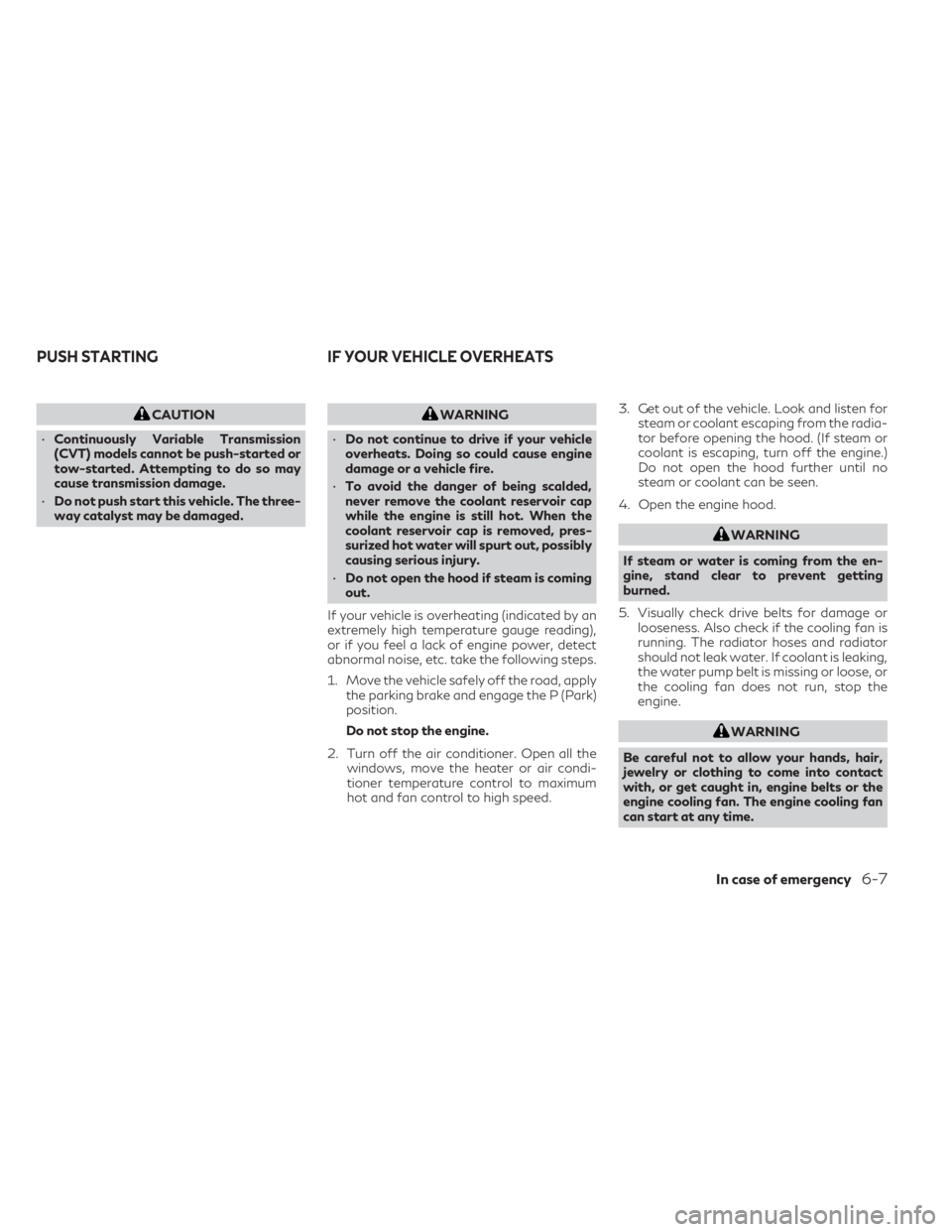
CAUTION
• Continuously Variable Transmission
(CVT) models cannot be push-started or
tow-started. Attempting to do so may
cause transmission damage.
• Do not push start this vehicle. The three-
way catalyst may be damaged.WARNING
• Do not continue to drive if your vehicle
overheats. Doing so could cause engine
damage or a vehicle fire.
• To avoid the danger of being scalded,
never remove the coolant reservoir cap
while the engine is still hot. When the
coolant reservoir cap is removed, pres-
surized hot water will spurt out, possibly
causing serious injury.
• Do not open the hood if steam is coming
out.
If your vehicle is overheating (indicated by an
extremely high temperature gauge reading),
or if you feel a lack of engine power, detect
abnormal noise, etc. take the following steps.
1. Move the vehicle safely off the road, apply the parking brake and engage the P (Park)
position.
Do not stop the engine.
2. Turn off the air conditioner. Open all the windows, move the heater or air condi-
tioner temperature control to maximum
hot and fan control to high speed. 3. Get out of the vehicle. Look and listen for
steam or coolant escaping from the radia-
tor before opening the hood. (If steam or
coolant is escaping, turn off the engine.)
Do not open the hood further until no
steam or coolant can be seen.
4. Open the engine hood.
WARNING
If steam or water is coming from the en-
gine, stand clear to prevent getting
burned.
5. Visually check drive belts for damage or looseness. Also check if the cooling fan is
running. The radiator hoses and radiator
should not leak water. If coolant is leaking,
the water pump belt is missing or loose, or
the cooling fan does not run, stop the
engine.
WARNING
Be careful not to allow your hands, hair,
jewelry or clothing to come into contact
with, or get caught in, engine belts or the
engine cooling fan. The engine cooling fan
can start at any time.
PUSH STARTING IF YOUR VEHICLE OVERHEATS
In case of emergency6-7
Page 418 of 542

6. After the engine cools down, check thecoolant level in the engine coolant reser-
voir tank with the engine running. Add
coolant to the engine coolant reservoir
tank if necessary. Have your vehicle re-
paired. It is recommended that you visit an
INFINITI retailer for this service. When towing your vehicle, all jurisdictions
and local regulations for towing must be fol-
lowed. Incorrect towing equipment could
damage your vehicle. Towing instructions are
available from an INFINITI retailer. Local ser-
vice operators are generally familiar with the
applicable laws and procedures for towing.
To assure proper towing and to prevent ac-
cidental damage to your vehicle, INFINITI
recommends having a service operator tow
your vehicle. It is advisable to have the service
operator carefully read the following
precautions:
WARNING
• Never ride in a vehicle that is being
towed.
• Never get under your vehicle after it has
been lifted by a tow truck.
CAUTION
• When towing, make sure that the trans-
mission, axles, steering system and pow-
ertrain are in working condition. Use dol-
lies or flatbed if any of the listed systems
are not working.
• Always attach safety chains before
towing. For additional information about towing your
vehicle behind a Recreational Vehicle (RV),
see “Flat towing for all-wheel drive vehicle”
(P. 10-28) or “Flat towing for front wheel
drive vehicle” (P. 10-29).
TOWING RECOMMENDED BY
INFINITI
INFINITI recommends towing your vehicle
based upon the type of drivetrain. For addi-
tional information, refer to the diagrams in
this section to ensure that your vehicle is
properly towed.
TOWING YOUR VEHICLE
6-8In case of emergency
Page 419 of 542

All-Wheel Drive (AWD) models with
Continuously Variable Transmission
(CVT)
INFINITI recommends that towing dollies be
used when towing your vehicle or place the
vehicle on a flatbed truck as illustrated.
CAUTION
Never tow AWD models equipped with a
Continuously Variable Transmission (CVT)
with any of the wheels on the ground as
this may cause serious and expensive dam-
age to the transfer case and transmission.
NOTE:
If the battery is completely drained the
transmission will not manually shift to other
positions.
LCE2370
In case of emergency6-9
Page 420 of 542

Two-Wheel Drive models with
Continuously Variable Transmission
(CVT)
INFINITI recommends that your vehicle be
towed with the driving (front) wheels off the
ground or place the vehicle on a flatbed truck
as illustrated.
NOTE:
If the electronic parking brake is released,
the rear wheels can be grounded while tow-
ing. If the electronic parking brake is not re-
leased, towing dollies should be used. For
additional information, see “Electronic
parking brake” (P. 5-23).
CAUTION
• Never tow Continuously Variable Trans-
mission (CVT) models with the front
wheels on the ground or four wheels on
the ground (forward or backward), as
this may cause serious and expensive
damage to the transmission. If it is nec-
essary to tow the vehicle with the rear
wheels raised always use towing dollies
under the front wheels.
• When towing Continuously Variable
Transmission (CVT) models with the rear
wheels on the ground or on towing
dollies:
– Place the ignition switch in the OFF
position, and secure the steering
wheel in a straight-ahead position
with a rope or similar device. Never
secure the steering wheel by placing
the ignition switch in the LOCK posi-
tion. This may damage the steering
lock mechanism (for models with a
steering lock mechanism).
NOTE:
If the battery is completely drained the
transmission will not manually shift to other
positions.
LCE2371
6-10In case of emergency
Page 421 of 542
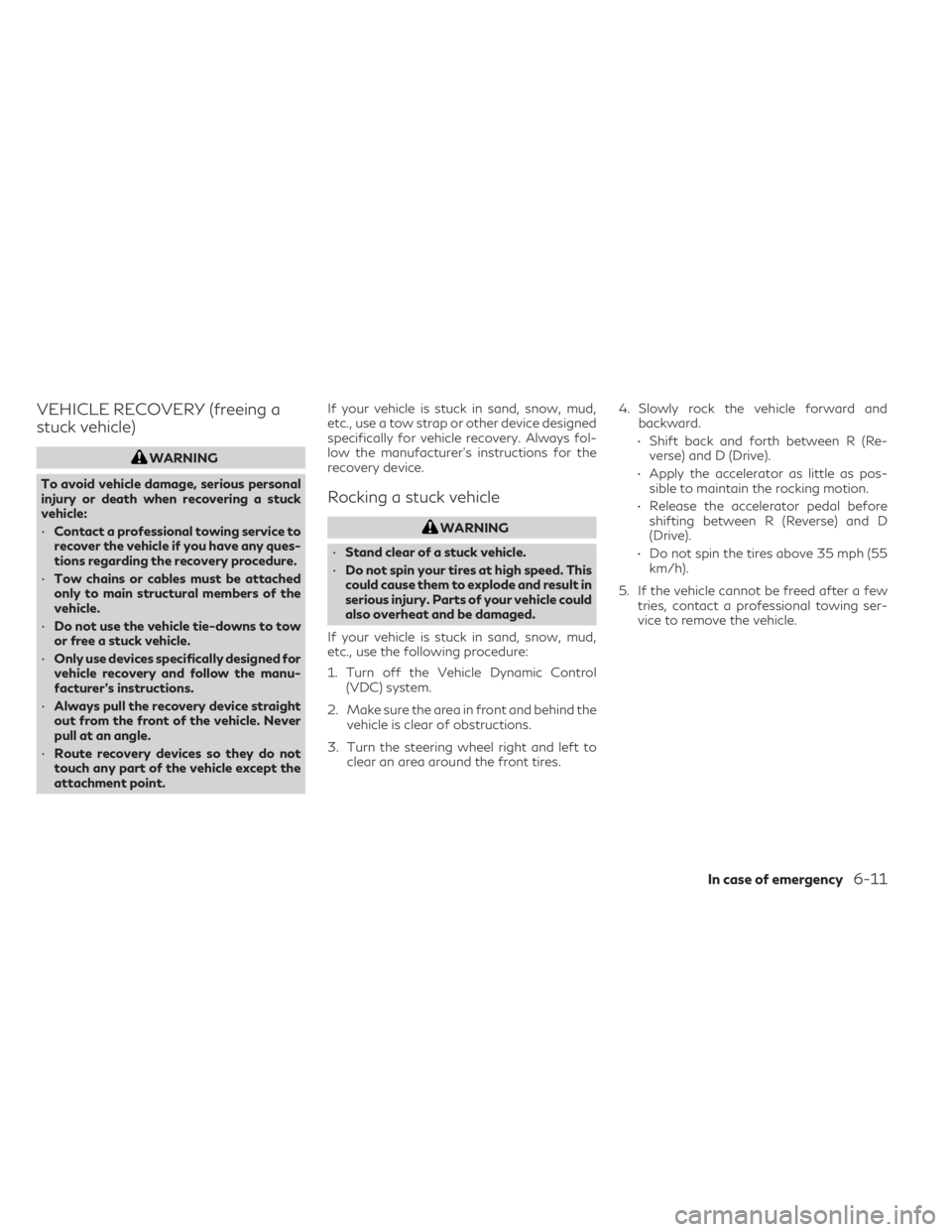
VEHICLE RECOVERY (freeing a
stuck vehicle)
WARNING
To avoid vehicle damage, serious personal
injury or death when recovering a stuck
vehicle:
• Contact a professional towing service to
recover the vehicle if you have any ques-
tions regarding the recovery procedure.
• Tow chains or cables must be attached
only to main structural members of the
vehicle.
• Do not use the vehicle tie-downs to tow
or free a stuck vehicle.
• Only use devices specifically designed for
vehicle recovery and follow the manu-
facturer's instructions.
• Always pull the recovery device straight
out from the front of the vehicle. Never
pull at an angle.
• Route recovery devices so they do not
touch any part of the vehicle except the
attachment point. If your vehicle is stuck in sand, snow, mud,
etc., use a tow strap or other device designed
specifically for vehicle recovery. Always fol-
low the manufacturer's instructions for the
recovery device.
Rocking a stuck vehicle
WARNING
• Stand clear of a stuck vehicle.
• Do not spin your tires at high speed. This
could cause them to explode and result in
serious injury. Parts of your vehicle could
also overheat and be damaged.
If your vehicle is stuck in sand, snow, mud,
etc., use the following procedure:
1. Turn off the Vehicle Dynamic Control (VDC) system.
2. Make sure the area in front and behind the vehicle is clear of obstructions.
3. Turn the steering wheel right and left to clear an area around the front tires. 4. Slowly rock the vehicle forward and
backward.
• Shift back and forth between R (Re- verse) and D (Drive).
• Apply the accelerator as little as pos- sible to maintain the rocking motion.
• Release the accelerator pedal before shifting between R (Reverse) and D
(Drive).
• Do not spin the tires above 35 mph (55 km/h).
5. If the vehicle cannot be freed after a few tries, contact a professional towing ser-
vice to remove the vehicle.
In case of emergency6-11
Page 426 of 542

• Wipe off excess tire dressing using a drytowel. Make sure the tire dressing is com-
pletely removed from the tire
tread/grooves.
• Allow the tire dressing to dry as recom- mended by tire dressing manufacturer. This vehicle has new and unique surfaces on
the center console and door pull finishers. If
cleaning is required use mild soap and water.
However if mild soap and water won’t clean
the center console and door pull finishers, use
Genuine INFINITI Vinyl and Leather Cleaner
(or equivalent).
Occasionally remove loose dust from the in-
terior trim, plastic parts and seats using a
vacuum cleaner or soft bristled brush. Wipe
the vinyl and leather surfaces with a clean,
soft cloth dampened in mild soap solution,
then wipe clean with a dry, soft cloth.
Regular care and cleaning is required in order
to maintain the appearance of the leather.
Before using any fabric protector, read the
manufacturer's recommendations. Some
fabric protectors contain chemicals that may
stain or bleach the seat material.
Use a cloth dampened only with water to
clean the meter and gauge lens.
Use a slightly moist (with water) microfiber
cloth to clean the wood trim. If necessary, use
water with natural soap or wood dedicated
cleaning products, such as furniture polish.WARNING
Do not use water or acidic cleaners (hot
steam cleaners) on the seat. This can dam-
age the seat or occupant classification sen-
sor. This can also affect the operation of
the air bag system and result in serious per-
sonal injury.
CAUTION
• Never use benzine, thinner, or any similar
material on the interior surfaces or sur-
face damage may occur. Such damage is
not covered under the INFINITI
warranty.
• Small dirt particles can be abrasive and
damaging to leather surfaces and should
be removed promptly. Do not use saddle
soap, car waxes, polishes, oils, cleaning
fluids, solvents, detergents or ammonia-
based cleaners as they may damage the
leather's natural finish.
• Never use fabric protectors unless rec-
ommended by the manufacturer.
• Do not use glass or plastic cleaner on me-
ter or gauge lens covers. It may damage
the lens cover.
CLEANING INTERIOR
7-4Appearance and care
Page 427 of 542
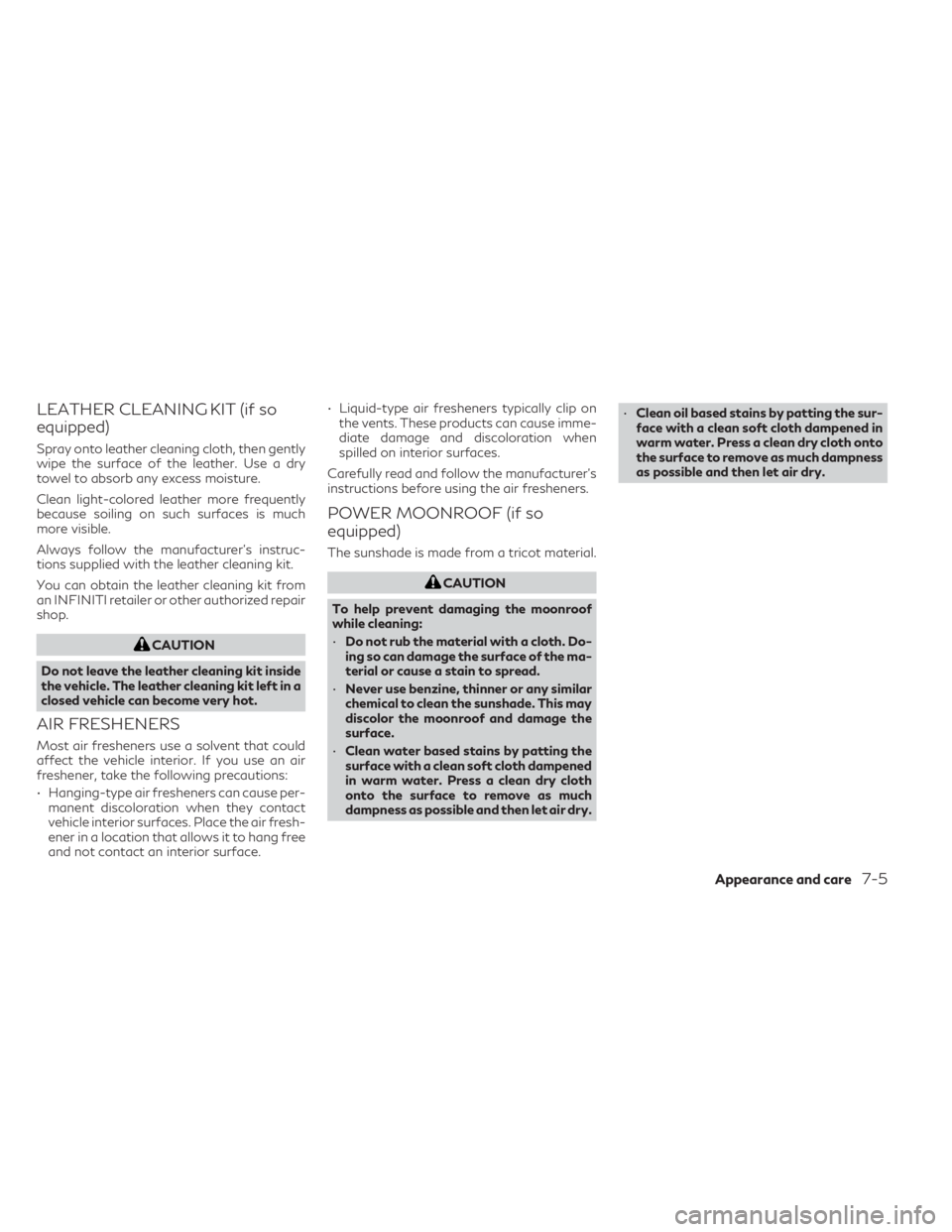
LEATHER CLEANING KIT (if so
equipped)
Spray onto leather cleaning cloth, then gently
wipe the surface of the leather. Use a dry
towel to absorb any excess moisture.
Clean light-colored leather more frequently
because soiling on such surfaces is much
more visible.
Always follow the manufacturer’s instruc-
tions supplied with the leather cleaning kit.
You can obtain the leather cleaning kit from
an INFINITI retailer or other authorized repair
shop.
CAUTION
Do not leave the leather cleaning kit inside
the vehicle. The leather cleaning kit left in a
closed vehicle can become very hot.
AIR FRESHENERS
Most air fresheners use a solvent that could
affect the vehicle interior. If you use an air
freshener, take the following precautions:
• Hanging-type air fresheners can cause per- manent discoloration when they contact
vehicle interior surfaces. Place the air fresh-
ener in a location that allows it to hang free
and not contact an interior surface. • Liquid-type air fresheners typically clip on
the vents. These products can cause imme-
diate damage and discoloration when
spilled on interior surfaces.
Carefully read and follow the manufacturer's
instructions before using the air fresheners.
POWER MOONROOF (if so
equipped)
The sunshade is made from a tricot material.
CAUTION
To help prevent damaging the moonroof
while cleaning:
• Do not rub the material with a cloth. Do-
ing so can damage the surface of the ma-
terial or cause a stain to spread.
• Never use benzine, thinner or any similar
chemical to clean the sunshade. This may
discolor the moonroof and damage the
surface.
• Clean water based stains by patting the
surface with a clean soft cloth dampened
in warm water. Press a clean dry cloth
onto the surface to remove as much
dampness as possible and then let air dry. •
Clean oil based stains by patting the sur-
face with a clean soft cloth dampened in
warm water. Press a clean dry cloth onto
the surface to remove as much dampness
as possible and then let air dry.
Appearance and care7-5
Page 477 of 542
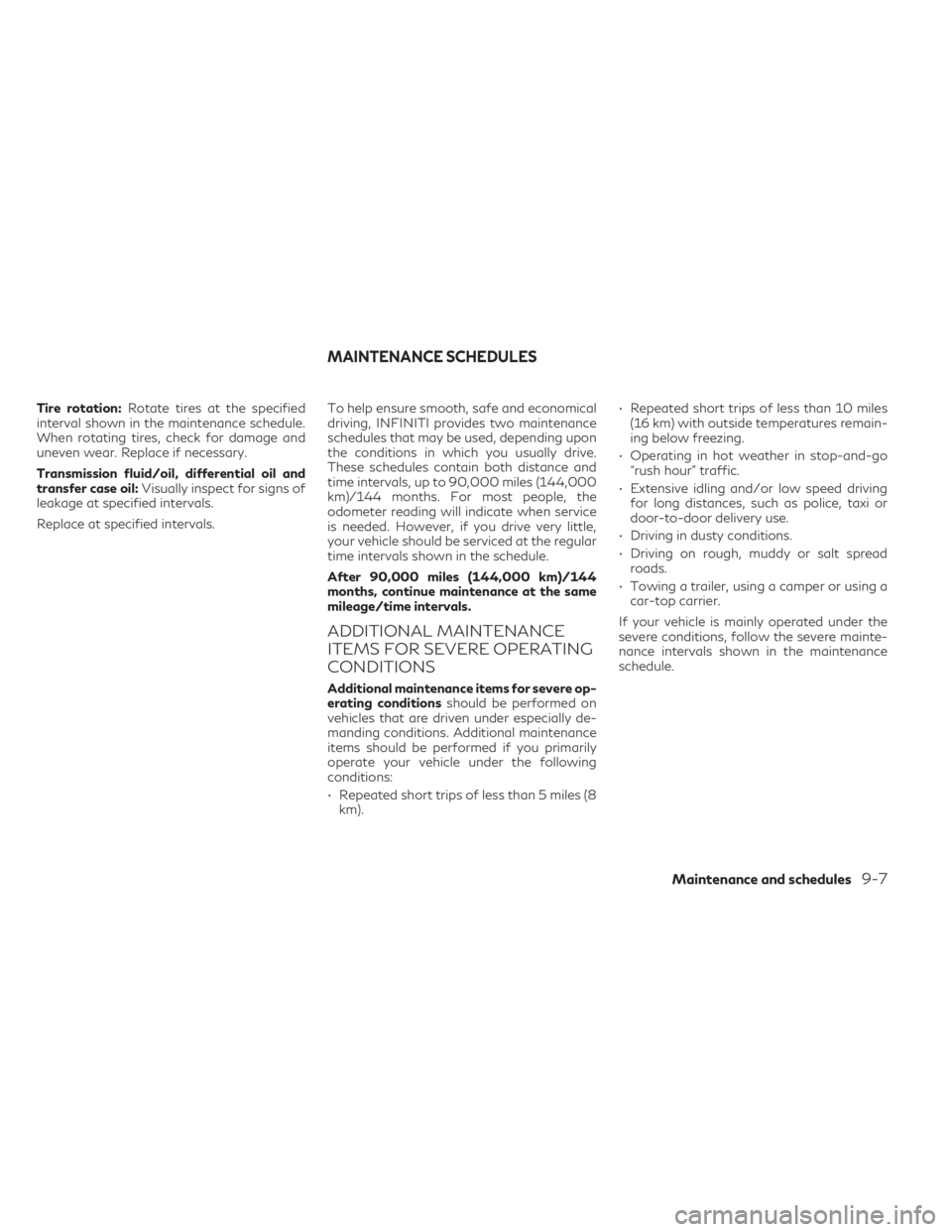
Tire rotation:Rotate tires at the specified
interval shown in the maintenance schedule.
When rotating tires, check for damage and
uneven wear. Replace if necessary.
Transmission fluid/oil, differential oil and
transfer case oil: Visually inspect for signs of
leakage at specified intervals.
Replace at specified intervals. To help ensure smooth, safe and economical
driving, INFINITI provides two maintenance
schedules that may be used, depending upon
the conditions in which you usually drive.
These schedules contain both distance and
time intervals, up to 90,000 miles (144,000
km)/144 months. For most people, the
odometer reading will indicate when service
is needed. However, if you drive very little,
your vehicle should be serviced at the regular
time intervals shown in the schedule.
After 90,000 miles (144,000 km)/144
months, continue maintenance at the same
mileage/time intervals.
ADDITIONAL MAINTENANCE
ITEMS FOR SEVERE OPERATING
CONDITIONS
Additional maintenance items for severe op-
erating conditions
should be performed on
vehicles that are driven under especially de-
manding conditions. Additional maintenance
items should be performed if you primarily
operate your vehicle under the following
conditions:
• Repeated short trips of less than 5 miles (8 km). • Repeated short trips of less than 10 miles
(16 km) with outside temperatures remain-
ing below freezing.
• Operating in hot weather in stop-and-go “rush hour” traffic.
• Extensive idling and/or low speed driving for long distances, such as police, taxi or
door-to-door delivery use.
• Driving in dusty conditions.
• Driving on rough, muddy or salt spread roads.
• Towing a trailer, using a camper or using a car-top carrier.
If your vehicle is mainly operated under the
severe conditions, follow the severe mainte-
nance intervals shown in the maintenance
schedule.
MAINTENANCE SCHEDULES
Maintenance and schedules9-7
Page 478 of 542
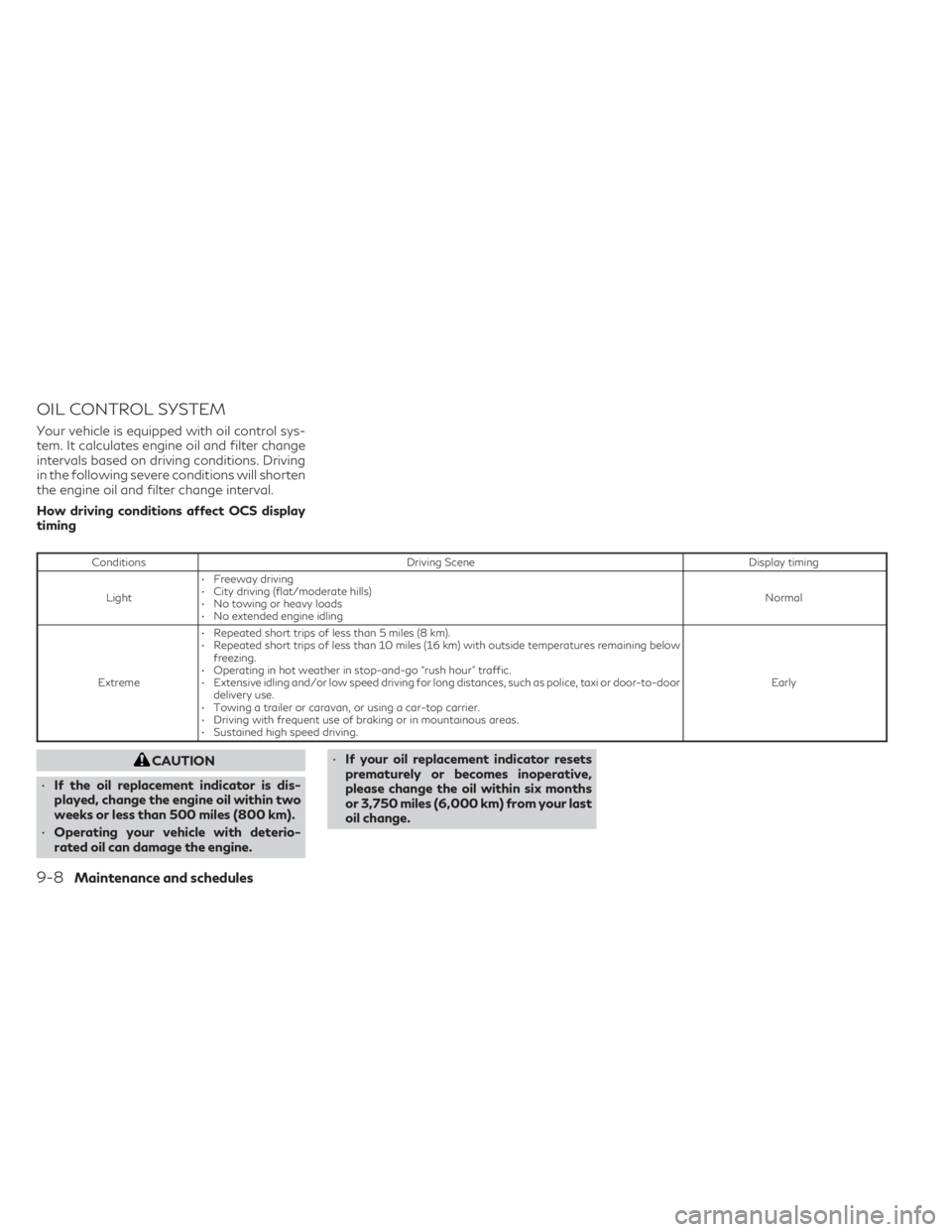
OIL CONTROL SYSTEM
Your vehicle is equipped with oil control sys-
tem. It calculates engine oil and filter change
intervals based on driving conditions. Driving
in the following severe conditions will shorten
the engine oil and filter change interval.
How driving conditions affect OCS display
timing
ConditionsDriving Scene Display timing
Light • Freeway driving
• City driving (flat/moderate hills)
• No towing or heavy loads
• No extended engine idling Normal
Extreme • Repeated short trips of less than 5 miles (8 km).
• Repeated short trips of less than 10 miles (16 km) with outside temperatures remaining below
freezing.
• Operating in hot weather in stop-and-go “rush hour” traffic.
• Extensive idling and/or low speed driving for long distances, such as police, taxi or door-to-door delivery use.
• Towing a trailer or caravan, or using a car-top carrier.
• Driving with frequent use of braking or in mountainous areas.
• Sustained high speed driving. Early
CAUTION
• If the oil replacement indicator is dis-
played, change the engine oil within two
weeks or less than 500 miles (800 km).
• Operating your vehicle with deterio-
rated oil can damage the engine. •
If your oil replacement indicator resets
prematurely or becomes inoperative,
please change the oil within six months
or 3,750 miles (6,000 km) from your last
oil change.
9-8Maintenance and schedules